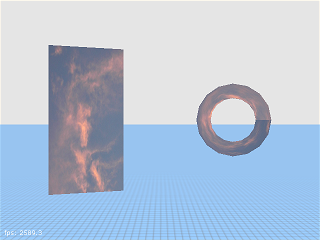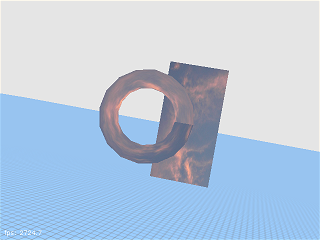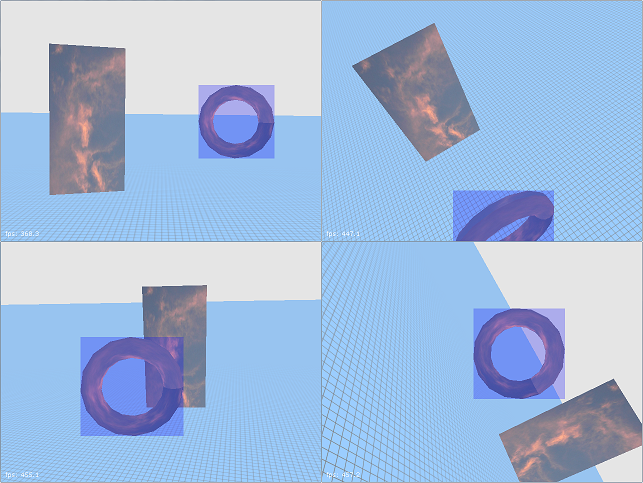 |
 |
 |
 |
| • | BillboardNodes: | Illustration of 2D and 3D billboards that always face the camera. |
| • | BlendedAnimations: | An animated skinned biped with an idle, walk, and run animation that are blended for smooth transitions. |
| • | BspNodes: | A BSP scene hierarchy for spatial ordering of objects. |
| • | CameraAndLightNodes: | Automatic updates of position and orientation for cameras and lights as nodes in a scene. |
| • | Castle: | A large scene that requires culling for fast rendering. The picking system is used for collision avoidance and staying on the ground. |
| • | CLODMeshes: | Continuous level of detail for a triangle mesh. |
| • | DLODNodes: | Discrete level of detail based on distance from camera. |
| • | IKControllers: | A simple inverse kinematics example with a few joints and a single end effector. |
| • | MorphControllers: | A morph of multiple surfaces. |
| • | MorphFaces: | A morphing face. The vertex color channel is interpolated during a portion of the animation. |
| • | ParticleControllers: | A simple particle system. |
| • | Picking: | Picking (selection) of geometric primitives (points, segments, triangles) using the mouse. |
| • | PointControllers: | A simple point system containing randomly moving points. |
| • | SwitchNodes: | Nodes for discrete level of detail by selecting a single child to draw. |
| • | Terrain: | A tiled terrain system with wrap-around tiles (toroidal topology). |
BillboardNodes. Illustration of 2D and 3D billboards that always face the camera.
A couple of images with different camera positions and orientations. In
each case, notice how the 2D and 3D billboards rotate about their model
axes to face the camera.
|
BlendedAnimations. Blending of idle, walk, and run cycles for a skinned biped.
The first image shows the biped in the idle cycle. The second image shows the biped
in the walk cycle. The third image shows the biped in the run cycle. When in idle,
you press the up-arrow and see a transition from idle to walking. Press shift-up-arrow
to see the transition from walking to running
|
BspNodes. Sorted drawing using coarse-level BSP trees.
The partitioning of the world by four BSP planes. Only the square region
defined by |x| ≤ 1 and |y| ≤ 1 is shown.
|
CameraAndLightNodes. Automatic updates of position and orientation for cameras and lights as nodes in a scene.
The first image shows a simple scene with a ground polygon and texture. The
Camera used for rendering is contained in a CameraNode object. The up-arrow
and down-arrow keys control the forward/backward translation of the
CameraNode. The left-arrow and right-arrow keys control the rotation of the
CameraNode about its up-axis. The spot-light illumination is actually
generated by a point light. However, the point light illuminates two triangle
meshes, each in the shape of a paraboloid. The meshes are positioned in such
a manner so that the ground polygon clips them, giving the appearance as if
the lit geometry forms disks. The meshes are also translucent, so you obtain
blending of the lit mesh and the ground, giving the appearance that the ground
is being lit. The second image shows a wireframe of the scene, so you can
see the actual lit meshes.
|
Castle. An outdoor environment plus a large castle data set. The screen captures were
made when the castle was unlit. The current code adds lighting via some simple
shaders.
On program initialization, the camera is placed far away from the castle.
The initial screenshot is the following image. Not much of the castle is
visible. The wireframe image shows what is occluded.
|
CLODMeshes. Continuous level of detail for a triangle mesh.
The left image shows two triangle-mesh faces. Both use CLODMesh for
continuous level of detail. The collapse records are shared between
the two objects. The current number of triangles used by the meshes
is displayed at the top of the screen. The right image shows the
scene rotated using the virtual trackball. The object closer to the
camera has a larger number of triangles than the object farther from
the camera. The triangle counts vary as the camera moves, whether
transations or rotations.
|
DLODNodes. Discrete level of detail based on distance from camera.
This is a simple application to show how to use the DLODNode class. The
sequence of models from highest level of detail to lowest level of detail is:
sphere, icosahedron, dodecahedron, octahedron, hexahedron, tetrahedron.
Initiallly, the camera is close to the sphere, which is then drawn. As the
camera is translated backward from the sphere, the model switches to the next
lower level of detail. The following images show the display just after each
switch point. The level of detail decreases from top row to bottom row, and
from left to right within each row. Naturally, in a real application you
would want a sequence of models that change gradually as each switch point
is encountered.
|
IKControllers. A simple inverse kinematics example with a few joints and a single end effector.
The left image shows the initial configuration. The box closest to the camera is
attached to the ground and is allowed only to rotate about its up axis. The
middle box is the end effector and is attached to the closest box by a rod
that is allowed to contract or expand in length. The middle box is allowed
only to translate vertically. The box farthest from the camera is the goal
that the end effector must try to reach. The middle and right images show that
the goal has been translated upward and toward the camera. The end effector has
translated vertically to match the height of the goal and the ground box has
rotated appropriately.
|
MorphControllers. A morph of multiple surfaces.
The left image shows one of the morphs of the multiple surfaces. The right
image shows a morph and wireframes of the multiple surfaces that act as the
morph targets.
|
MorphFaces. A morphing face. The vertex color channel is interpolated during a portion of the animation.
The sequence is somewhat lengthy. Here are a few screen captures during the morphing.
|
ParticleControllers. A simple particle system.
The particles are billboarded squares, each with an RGBA texture. The
alpha channel is selected so that the squares appear as if they are fuzzy
red disks (red blood cells randomly moving about). A couple of screen
captures are shown next.
|
Picking. Picking (selection) of geometric primitives. The pick ray origin is the camera
world position and the pick ray direction is the that from the camera world
position through the point on the near plane corresopnding to where a mouse
click event occurred.
The images are numbered from left to right.
Image0 is an image showing four geometric primitives: a torus,
a dodecahedron, a polyline, and a set of four points. Image1
shows the scene where a mouse click was used to select objects. The
first point on the ray is shown as a black sphere. Image2 shows
a different view of the scene so that you can see the pick ray
intersected the torus 4 times and the dodecahedron 2 times (6 black
spheres). Image3 shows the scene where the mouse click occurred
near the polyline. The nearest point on the polyline to the pick ray
is drawn as a black sphere. Image4 shows the scene where the
mouse click occurred near one of the four point primitives. The nearest
point to the pick ray is drawn as a black sphere. Image5 shows the
scene where the mouse click occured near the polyline and the pick ray
intersects the torus; the scene was rotated slightly so that you can see
both spheres that indicate the picked points.
|
PointControllers. A simple point system containing randomly moving points.
The left image is the initial configuration. The right image has the camera moved
far away from the points.
|
SwitchNodes. Nodes for discrete level of detail by selecting a single child to draw.
The scene graph has a SwitchNode with 11 children but only one of them is active at a time.
The application allows you to press the 'c' key to select the next child to be active. The
first four children are shown in the images.
|
Terrain. A tiled terrain system with wrap-around tiles (toroidal topology).
Two screen captures from the sample application. The fog is obtained via the
vertex shader and increases in density exponentially with depth. The height
of the camera over the terrain at its current location is displayed. The
normal vector of the height field at that location is also displayed.
|